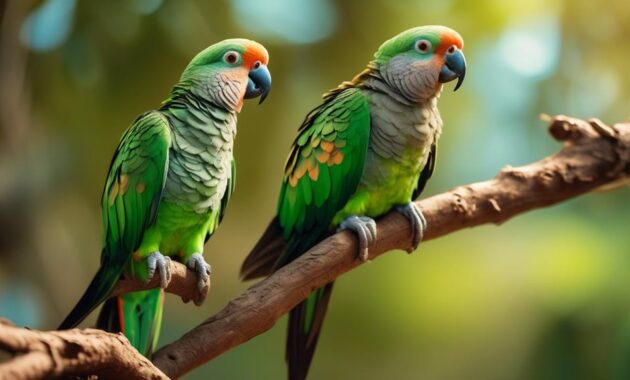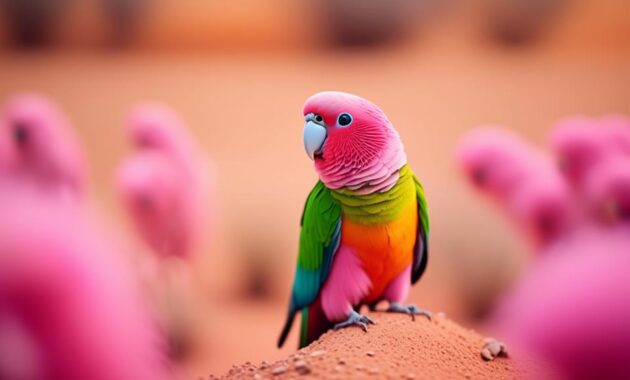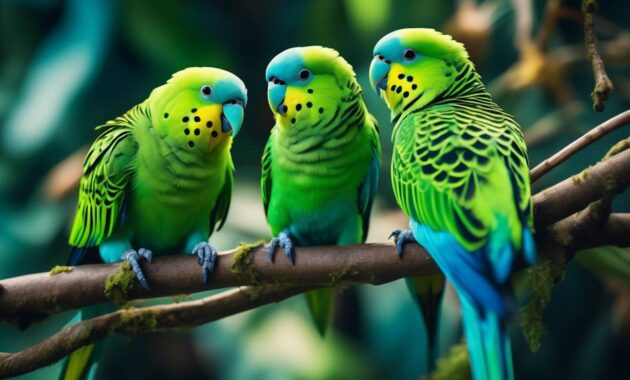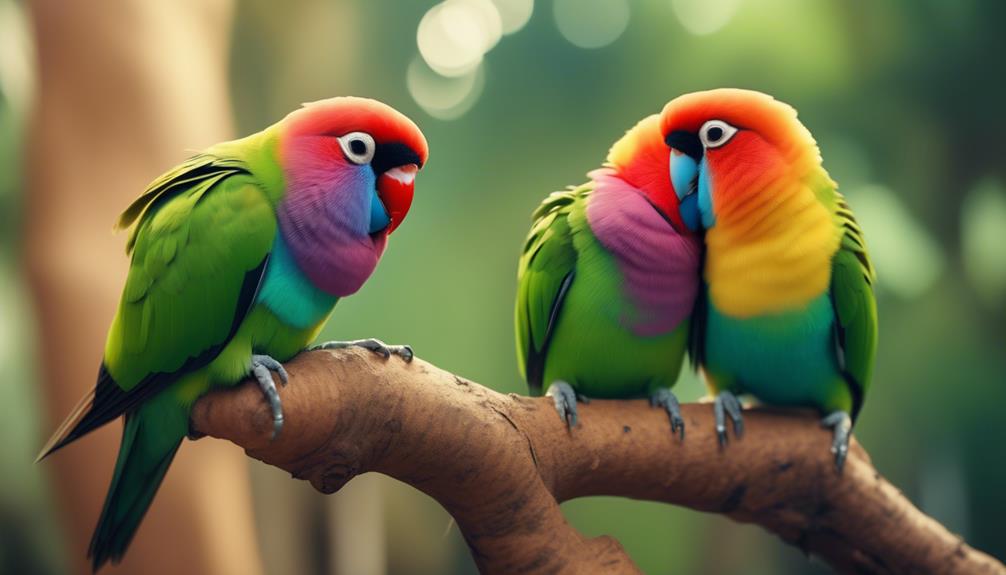
Have you ever wondered why Masked Lovebirds are known for their vibrant colors and captivating personalities? It's fascinating to explore the theories behind their striking appearance and learn more about their natural habitat.
But, there is so much more to uncover about these charming parrots.
So, get ready to embark on a journey where we unravel the secrets of their colors, habitat, and other intriguing facts.
You won't believe what awaits you in the world of Masked Lovebirds.
Key Takeaways
- Masked Lovebirds come in various colors such as green, yellow, and blue, adding to their visual appeal.
- They are native to northeast Tanzania, with some populations in Kenya and Burundi, and prefer dry regions with sparse growth close to woodlands.
- Masked Lovebirds have a distinctive black mask that covers most of their face and head, making them easily recognizable.
- These birds have a lifespan of 15-20 years and are known for their hardy health and adaptability to common conditions.
Physical Characteristics
Masked Lovebirds have a distinctive stocky and chubby appearance, with a unique feature being the black mask that covers most of their face and head. These parrots are approximately 6 inches in length and come in various colors such as green, yellow, and blue.
They're native to northeast Tanzania, with some populations in Kenya and Burundi. Masked Lovebirds prefer dry regions with sparse growth close to woodlands and can be found near sources of fresh water.
With short tails and a playful nature, these birds are known for their energetic and inquisitive personalities. They enjoy exploring their surroundings and forming strong bonds with their owners.
With their adorable chubby appearance and the striking black mask, Masked Lovebirds make a great pet for bird lovers.
Habitat and Distribution
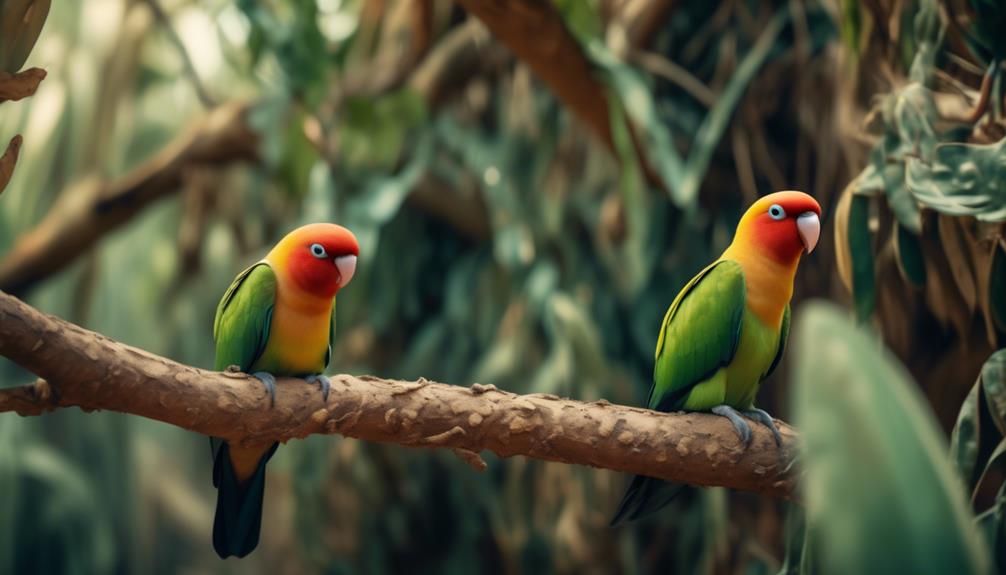
The natural habitat and distribution of Masked Lovebirds extend across northeast Tanzania, with some populations also found in Kenya and Burundi. These lovebirds prefer dry regions with sparse growth close to woodlands, and they can often be found near sources of fresh water. They thrive in areas with optimal temperature and sufficient sunlight.
Masked Lovebirds have adapted well to common conditions and are known for their hardy health. In terms of distribution, their range is primarily in northeast Tanzania, but they can also be found in neighboring countries like Kenya and Burundi. These vibrant and playful birds bring color and joy to their natural habitats.
Lifespan and Health
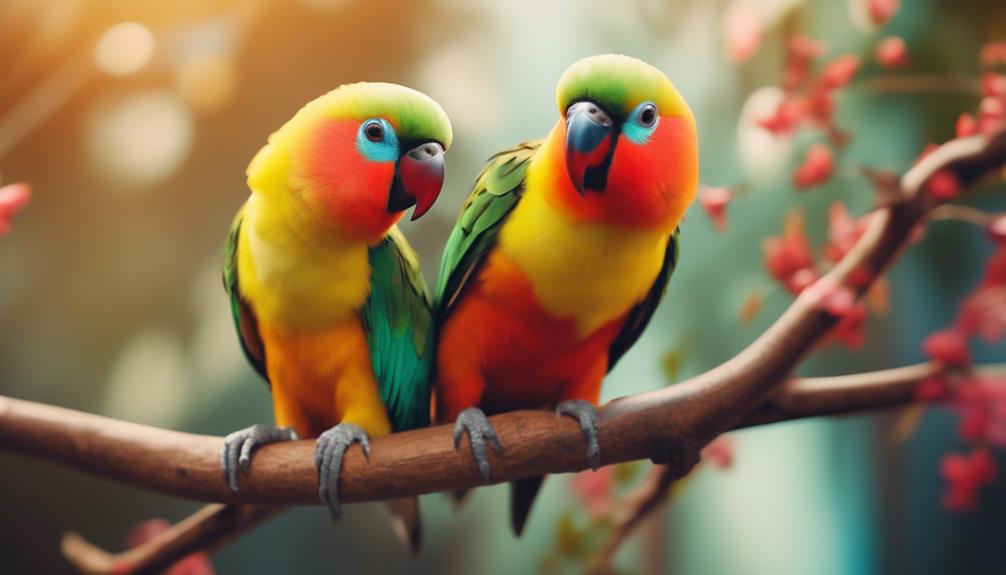
As we move on to the topic of Lifespan and Health, let's explore the longevity and well-being of these vibrant and playful Masked Lovebirds.
- Lifespan: Masked Lovebirds have a lifespan of 15-20 years.
- Health and Common Conditions: Masked Lovebirds are known for their hardy health and adaptability to common conditions. Optimal temperature, sufficient sunlight, and good hygiene are necessary for their well-being. Allowing them plenty of flying time outside the cage promotes their happiness and health.
- Exercise and Mental Stimulation: Regular exercise and mental stimulation are vital for the overall health and happiness of Masked Lovebirds. They enjoy toys, puzzles, and interactive playtime with their owners. Providing a variety of perches and climbing structures in their cage helps keep them physically active.
Care and Feeding
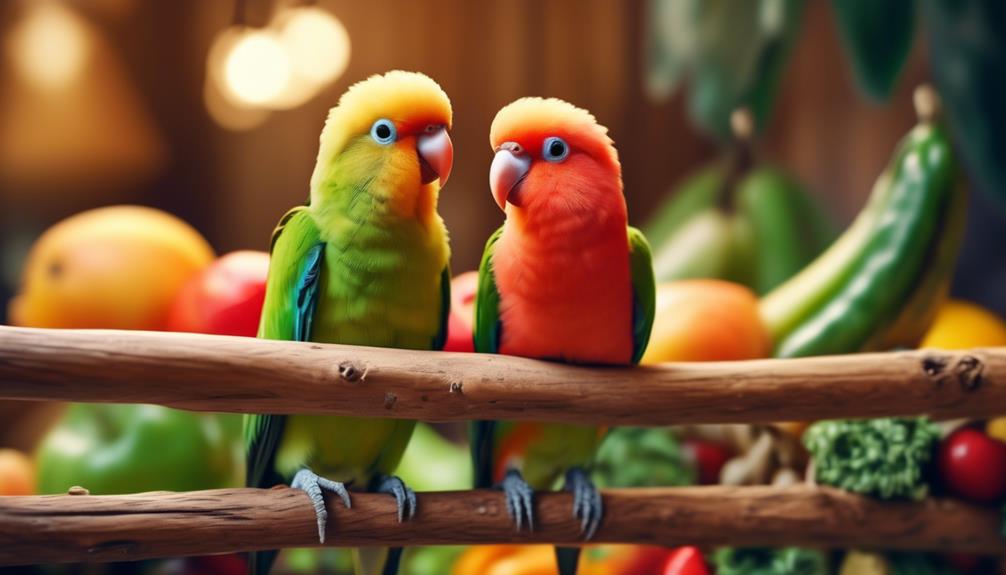
To properly care for your Masked Lovebirds, it's important to understand their specific needs when it comes to feeding and overall care.
Their diet consists of seeds, fruits, crops, and nuts. You can provide them with pre-made seed and pellet mixes designed for lovebirds, along with fresh green vegetables and fruits to balance their diet.
Make sure to offer them a regular bathing dish and clean drinking water for their hygiene.
Additionally, these birds thrive on social interaction, so spending quality time with them is essential for their happiness and well-being.
Remember to provide them with plenty of flying time outside the cage to promote their physical and mental stimulation.
Personality and Behavior
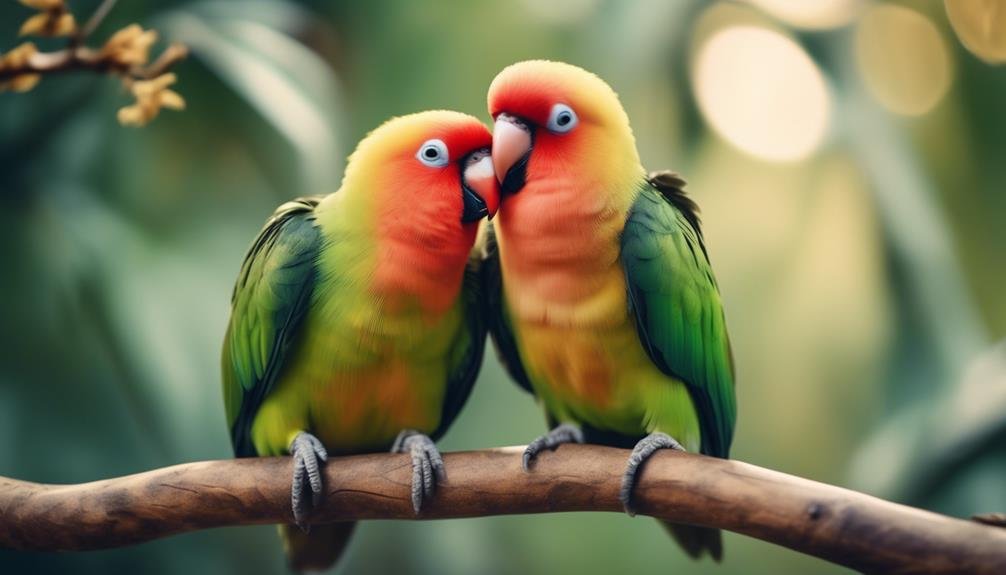
Get ready to discover the energetic and playful personality of Masked Lovebirds. These adorable birds are full of life and will bring joy to your home with their vibrant personalities. Here are three key traits that define their behavior:
- Curiosity: Masked Lovebirds are incredibly inquisitive creatures. They love exploring their surroundings and investigating new objects or toys. Their curiosity drives them to constantly seek out new experiences and keeps them engaged with their environment.
- Playfulness: These birds have an innate sense of playfulness that's truly contagious. They enjoy engaging in interactive games and will happily entertain themselves by tossing around toys or engaging in acrobatic feats. Their playful nature is sure to keep you entertained for hours on end.
- Social Interaction: Masked Lovebirds thrive on social interaction and form strong bonds with their owners. They enjoy spending time with their human companions and will eagerly seek out attention and affection. They love being part of the family and will eagerly participate in activities or simply snuggle up for some quality bonding time.
With their boundless energy and charming personalities, Masked Lovebirds make delightful pets that will bring endless joy and entertainment to your life.
Sounds and Vocalizations
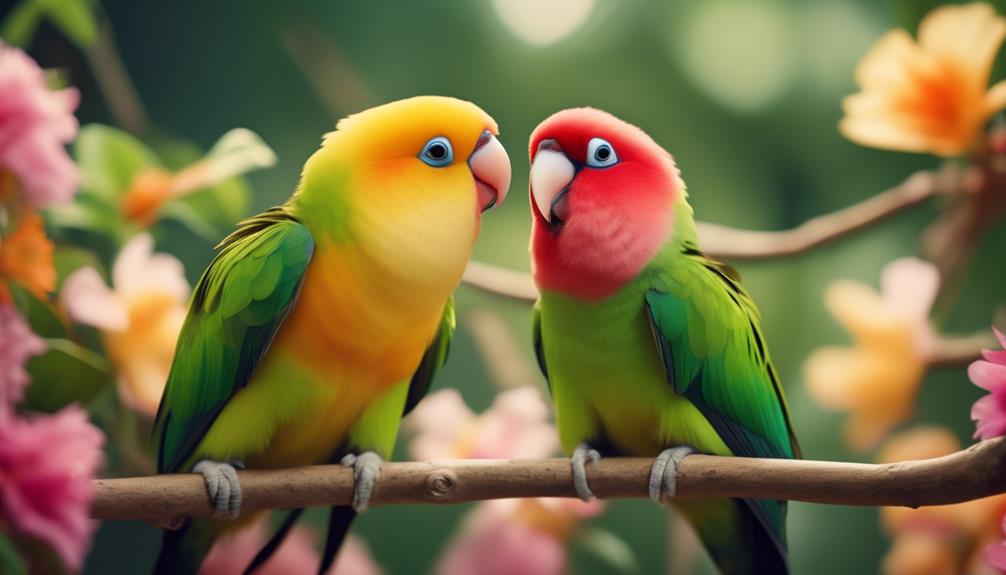
Masked Lovebirds are known for their vocal sounds, chirping, and singing noises. These birds are quite vocal and use various sounds to communicate with each other and their owners. They've a wide range of vocalizations, from soft chirps to loud squawks. Lovebirds use their sounds to express their emotions, such as happiness, excitement, or even warning signals.
Their singing noises can be quite melodic and pleasant to the ears. It's important to note that each lovebird has its own unique voice and sound. By paying attention to their vocalizations, you can better understand their needs and emotions, and build a stronger bond with your pet.
Sex Determination
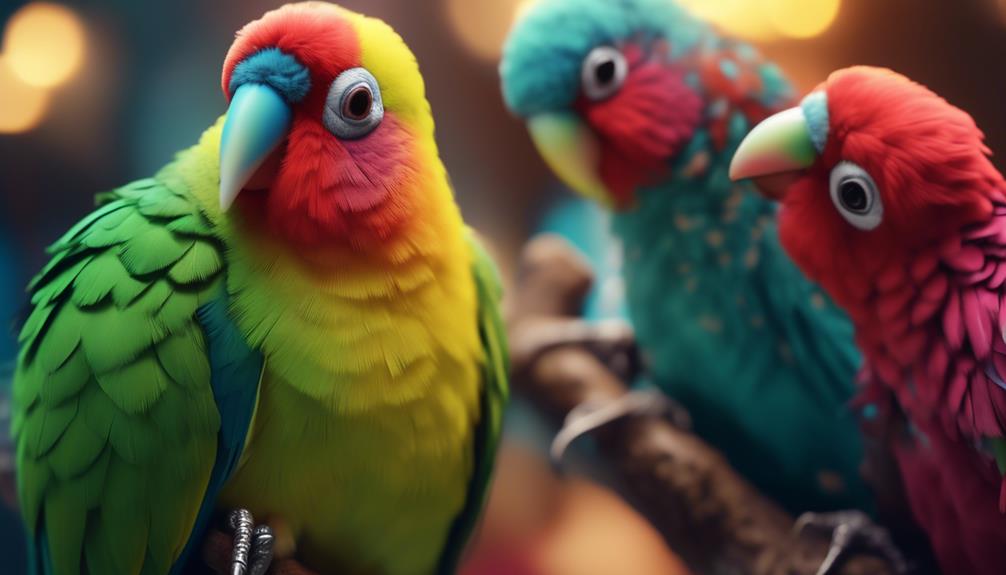
Determining the sex of Masked Lovebirds can be a challenging task due to their physical similarities. Here are some key points to consider when trying to determine the sex of these birds:
- Visual Observation: Males and females of Masked Lovebirds look almost identical in terms of physical appearance. They've similar body size, coloration, and overall features, making it difficult to differentiate them based solely on visual observation.
- DNA Testing: The most accurate method to determine the sex of Masked Lovebirds is through DNA testing. This involves collecting a blood or feather sample and sending it to a specialized laboratory for analysis. DNA testing can identify the presence of specific sex chromosomes and provide conclusive results.
- Behavioral Differences: While not foolproof, some behavioral differences may offer clues about the sex of Masked Lovebirds. Males tend to be more vocal and may engage in courtship displays, such as head bobbing and wing flapping, to attract a mate.
Frequently Asked Questions
What Is the Average Clutch Size of Masked Lovebirds?
The average clutch size of masked lovebirds is usually around 4-6 eggs. They are good parents and take care of their offspring diligently. Providing a suitable nesting box or cavity is important for successful breeding.
Do Masked Lovebirds Have Any Natural Predators in Their Habitat?
Yes, masked lovebirds have natural predators in their habitat. These predators include snakes, birds of prey, and mammals like cats and rats. It's important for them to have shelter and protection to avoid being hunted.
Can Masked Lovebirds Learn to Mimic Human Speech?
Yes, masked lovebirds can learn to mimic human speech. They are intelligent birds and can be trained to imitate words and phrases. With patience and consistent training, they can develop the ability to communicate in a human-like manner.
How Often Should Masked Lovebirds Be Taken to the Veterinarian for Check-Ups?
You should take your masked lovebirds to the veterinarian for regular check-ups at least once a year. Regular check-ups are important to ensure their health and well-being, and to catch any potential issues early on.
Are Masked Lovebirds Prone to Any Specific Diseases or Health Issues?
Masked Lovebirds are generally hardy and adaptable to common conditions, but they can be prone to specific diseases and health issues. Regular veterinary check-ups are recommended to ensure their well-being and catch any potential problems early.
What Makes Masked Lovebirds and Citron Crested Cockatoos Unique in Terms of Appearance and Behavior?
Masked lovebirds and elegant citron crested cockatoos are unique in both appearance and behavior. The masked lovebirds have striking colors and are small in size, known for their playful and social nature. On the other hand, the elegant citron crested cockatoo is larger and known for its extravagant crest and affectionate behavior with their owners.
Conclusion
In conclusion, Masked Lovebirds are truly captivating creatures with their striking colors and playful personalities.
From their stocky appearance to their distinctive black mask, they're a sight to behold.
Their preferred habitat and the key elements for their well-being are important to consider as their owners. With the right care and feeding, these birds can live a long and healthy life.
Their unique sounds and vocalizations add to their charm, and determining their sex can be a challenge.
Explore the wonders of Masked Lovebirds and enjoy the colorful world they bring.


